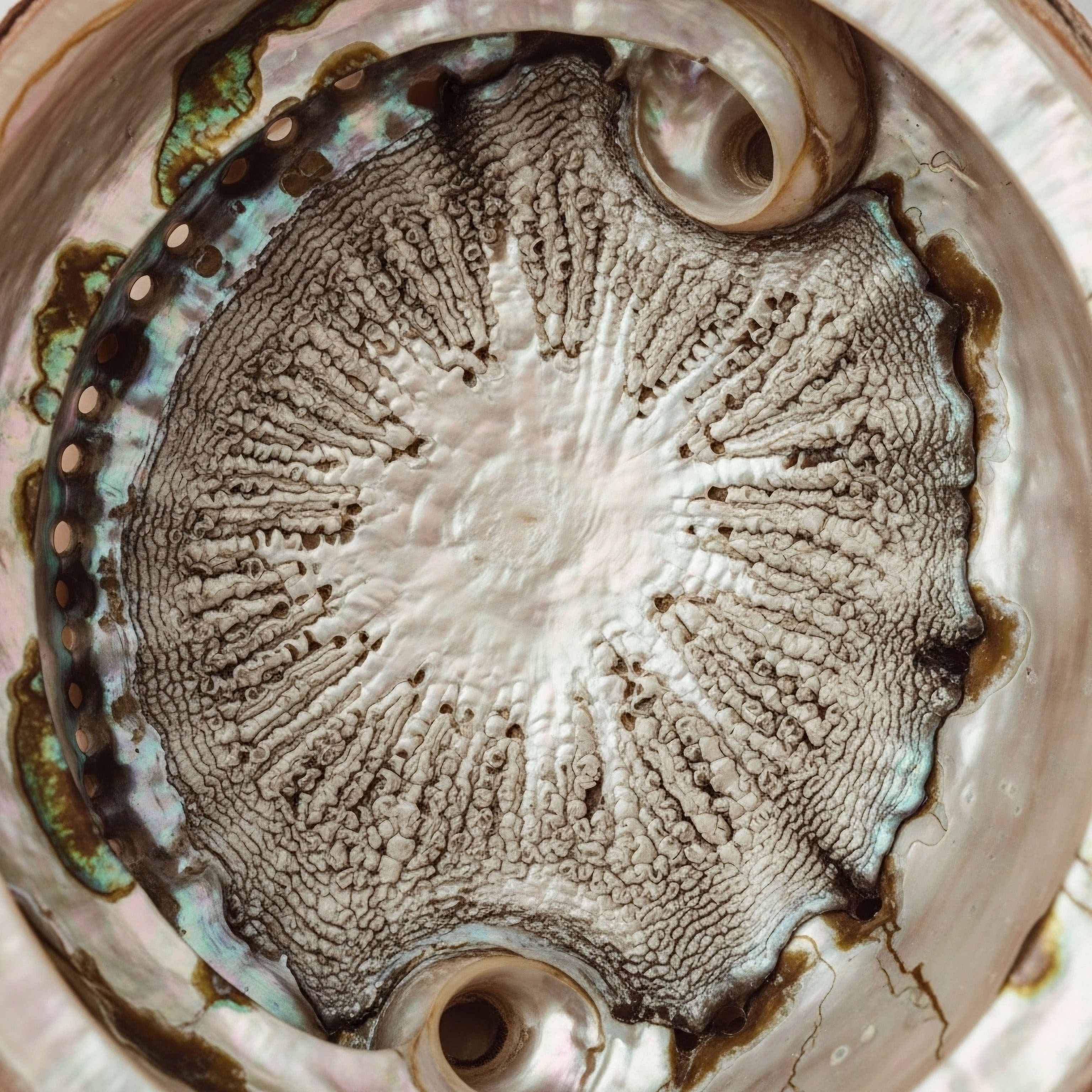

Fundamentals
When symptoms of diminished vitality begin to surface ∞ a persistent weariness, a subtle shift in mood, or a noticeable decline in physical resilience ∞ it can feel as though a fundamental aspect of your being is slipping away. This experience is not merely a sign of aging; it often points to deeper, interconnected shifts within your body’s intricate messaging systems.
Many individuals find themselves grappling with a sense of loss, a yearning to reclaim the energy and clarity that once defined their daily existence. Understanding these sensations as a signal from your biological systems, rather than an inevitable decline, marks the initial step toward restoring optimal function.
The endocrine system, a network of glands producing chemical messengers, orchestrates nearly every physiological process. These messengers, known as hormones, regulate metabolism, growth, mood, and reproductive function. When these biochemical signals become imbalanced, the repercussions can ripple throughout the entire system, leading to the very symptoms that prompt a search for answers.
A decline in testosterone, for instance, can manifest not only as reduced libido or muscle mass but also as a pervasive lack of motivation or a diminished capacity for cognitive focus.
Understanding your body’s subtle signals is the first step toward reclaiming vitality and optimal function.
The concept of hormonal optimization protocols seeks to recalibrate these internal systems, guiding them back to a state of equilibrium. This approach acknowledges that individual biological systems possess a unique set point, and that supporting these systems can lead to a restoration of well-being. It is a journey of self-discovery, where scientific understanding meets personal experience, allowing for a precise and tailored intervention.

The Endocrine System and Its Messengers
The human body operates through a sophisticated communication network, where glands release specific substances directly into the bloodstream. These substances then travel to target cells, initiating a wide array of physiological responses. The hypothalamic-pituitary-gonadal axis (HPG axis) stands as a central regulatory pathway, governing the production of sex steroids.
The hypothalamus releases gonadotropin-releasing hormone (GnRH), which stimulates the pituitary gland to secrete luteinizing hormone (LH) and follicle-stimulating hormone (FSH). These gonadotropins, in turn, act on the gonads ∞ the testes in men and ovaries in women ∞ to produce testosterone, estrogen, and progesterone.
Disruptions within this axis, whether due to age, environmental factors, or lifestyle choices, can lead to a cascade of effects. For men, a decrease in testicular testosterone production, often termed hypogonadism or andropause, can result in a constellation of symptoms. Women, particularly during perimenopause and post-menopause, experience significant fluctuations and declines in estrogen, progesterone, and testosterone, contributing to symptoms like hot flashes, irregular cycles, and altered body composition.

Peptides as Biological Modulators
Beyond the classical hormones, another class of biological messengers, peptides, plays a significant role in cellular communication and regulation. Peptides are short chains of amino acids, acting as signaling molecules that can influence various physiological processes. They differ from hormones in their structure and often in their more targeted mechanisms of action. Many peptides function by binding to specific receptors on cell surfaces, initiating intracellular signaling pathways that can regulate hormone secretion, metabolic processes, tissue repair, and even neurological function.
The use of specific peptides in conjunction with testosterone replacement therapy (TRT) represents a sophisticated approach to hormonal optimization. This combined strategy aims not only to address a deficiency in testosterone but also to support the body’s intrinsic capacity for self-regulation and repair.
It considers the broader systemic impact, seeking to optimize overall well-being rather than merely treating isolated symptoms. The long-term implications of such combined protocols warrant a detailed exploration, considering both the benefits and the careful monitoring required to ensure sustained health.


Intermediate
Addressing hormonal imbalances often involves a precise recalibration of the body’s internal chemistry. Testosterone replacement therapy (TRT) serves as a foundational intervention for individuals experiencing symptomatic testosterone deficiency. However, the integration of specific peptides alongside TRT represents a more refined strategy, aiming to optimize outcomes and mitigate potential systemic challenges. This approach acknowledges that the endocrine system operates as a symphony, where each component influences the others.
For men, the standard protocol for Testosterone Cypionate typically involves weekly intramuscular injections. This exogenous testosterone effectively raises circulating levels, alleviating symptoms associated with low testosterone. Yet, introducing external testosterone can suppress the body’s natural production by signaling to the pituitary gland that sufficient testosterone is present, thereby reducing LH and FSH secretion. This suppression can lead to testicular atrophy and impaired fertility.
Combining peptides with testosterone therapy offers a refined strategy for hormonal optimization, addressing both deficiency and systemic balance.

Gonadorelin and Fertility Preservation
To counteract the suppression of endogenous testosterone production and preserve fertility, Gonadorelin is frequently incorporated into male TRT protocols. Gonadorelin, a synthetic analog of GnRH, stimulates the pituitary gland to release LH and FSH. Administered via subcutaneous injections, typically twice weekly, it helps maintain testicular function and size, allowing for continued natural testosterone synthesis even while exogenous testosterone is being supplied. This dual approach supports the HPG axis, preventing the complete shutdown of intrinsic hormonal pathways.
The long-term use of Gonadorelin with TRT aims to sustain the delicate balance of the male reproductive system. It helps to prevent the irreversible atrophy that can occur with TRT alone, preserving the option for future fertility. This consideration is particularly relevant for younger men or those who anticipate future family planning.

Estrogen Management with Anastrozole
Testosterone can undergo a process called aromatization, converting into estrogen within the body. While some estrogen is essential for male health, excessive levels can lead to undesirable effects such as gynecomastia, water retention, and mood disturbances. To manage this, Anastrozole, an aromatase inhibitor, is often prescribed. Administered orally, typically twice weekly, Anastrozole blocks the enzyme responsible for estrogen conversion, helping to maintain a healthy testosterone-to-estrogen ratio.
Long-term management of estrogen levels is critical for men on TRT. Uncontrolled estrogen can negate some of the benefits of testosterone optimization and introduce new challenges. The precise dosing of Anastrozole is individualized, based on regular blood work, to ensure optimal hormonal balance without excessively suppressing estrogen, which also plays a role in bone density and cardiovascular health.

Female Hormonal Balance and Peptides
Women also experience the benefits of hormonal optimization, particularly with low-dose testosterone and progesterone. For pre-menopausal, peri-menopausal, and post-menopausal women, symptoms like irregular cycles, mood changes, hot flashes, and diminished libido can significantly impact quality of life. Testosterone Cypionate, typically administered weekly via subcutaneous injection at very low doses (e.g.
0.1 ∞ 0.2ml), can improve energy, mood, and sexual function. Progesterone is often prescribed alongside, especially for women with intact uteruses, to support uterine health and balance estrogen.
Pellet therapy, offering long-acting testosterone, presents another option for women, providing consistent hormonal delivery over several months. Anastrozole may be considered in specific cases where estrogen levels become disproportionately high, even at low testosterone doses.

Growth Hormone Peptides and Systemic Support
Beyond direct hormonal modulation, specific growth hormone-releasing peptides (GHRPs) and growth hormone-releasing hormones (GHRHs) offer systemic benefits that complement hormonal optimization. These peptides stimulate the body’s natural production of growth hormone (GH), which declines with age.
Commonly utilized peptides include:
- Sermorelin ∞ A GHRH analog that stimulates the pituitary to release GH. Its action is physiological, promoting pulsatile GH release.
- Ipamorelin / CJC-1295 ∞ Ipamorelin is a GHRP that selectively stimulates GH release without significantly impacting cortisol or prolactin. CJC-1295 is a GHRH analog that has a longer half-life, providing sustained GH release.
Often combined, they offer a synergistic effect.
- Tesamorelin ∞ A GHRH analog approved for HIV-associated lipodystrophy, it also shows promise in reducing visceral fat and improving body composition.
- Hexarelin ∞ A potent GHRP, similar to Ipamorelin, but with a greater impact on GH release.
- MK-677 ∞ An oral GH secretagogue that stimulates GH release by mimicking ghrelin.
The long-term effects of these peptides, when used with testosterone, are centered on enhancing metabolic function, supporting tissue repair, improving sleep quality, and promoting favorable body composition changes. They work by augmenting the body’s intrinsic growth hormone axis, which plays a role in protein synthesis, fat metabolism, and cellular regeneration.

Targeted Peptides for Specific Concerns
Other peptides address specific physiological needs, offering a targeted approach to wellness:
- PT-141 (Bremelanotide) ∞ This peptide acts on melanocortin receptors in the brain to address sexual dysfunction in both men and women. Its mechanism is central, influencing desire and arousal pathways.
- Pentadeca Arginate (PDA) ∞ A peptide designed to support tissue repair, reduce inflammation, and accelerate healing processes. It is often considered for recovery from injury or to support general tissue integrity.
The integration of these peptides into a personalized wellness protocol alongside testosterone therapy reflects a comprehensive understanding of human physiology. It moves beyond a simplistic view of hormonal deficiency, recognizing the complex interplay of various signaling molecules in maintaining health and vitality. The long-term safety and efficacy of these combined protocols are continuously being evaluated through clinical observation and ongoing research.

Comparing Hormonal and Peptide Protocols
Understanding the distinct roles and synergistic potential of various agents is crucial for optimizing health outcomes. The table below provides a comparative overview of key protocols and their primary objectives.
| Protocol Component | Primary Mechanism of Action | Key Long-Term Benefit/Consideration |
|---|---|---|
| Testosterone Cypionate (Men) | Exogenous testosterone replacement | Restoration of male vitality, muscle mass, bone density; potential HPG axis suppression. |
| Testosterone Cypionate (Women) | Low-dose exogenous testosterone support | Improved libido, mood, energy; careful dosing to avoid virilization. |
| Gonadorelin | Stimulates pituitary LH/FSH release | Preservation of endogenous testosterone production and fertility in men. |
| Anastrozole | Aromatase inhibition | Estrogen management, reduction of TRT side effects; careful monitoring to avoid over-suppression. |
| Sermorelin/Ipamorelin/CJC-1295 | Stimulates natural growth hormone release | Improved body composition, sleep, tissue repair; physiological GH augmentation. |
| PT-141 | Melanocortin receptor agonist | Central modulation of sexual desire and arousal; non-hormonal pathway. |
| Pentadeca Arginate | Tissue repair and anti-inflammatory support | Accelerated healing, reduced systemic inflammation; supports cellular integrity. |


Academic
The long-term effects of peptide use in conjunction with testosterone therapy represent a frontier in personalized medicine, demanding a deep understanding of endocrinology, cellular signaling, and metabolic pathways. This integrated approach moves beyond symptomatic relief, aiming for a comprehensive recalibration of physiological systems. The complexity arises from the intricate interplay between exogenous hormones, endogenous feedback loops, and the targeted actions of various peptides.
Consider the profound implications of modulating the growth hormone axis while simultaneously optimizing androgen levels. Growth hormone (GH) and insulin-like growth factor 1 (IGF-1) play pivotal roles in anabolism, glucose metabolism, and cellular repair. Age-related decline in GH secretion contributes to sarcopenia, increased adiposity, and diminished tissue regeneration.
Peptides like Sermorelin and Ipamorelin/CJC-1295 act as secretagogues, stimulating the pituitary gland’s somatotrophs to release GH in a pulsatile, physiological manner. This contrasts with exogenous GH administration, which can suppress natural production and potentially lead to desensitization of GH receptors.
The combined use of peptides and testosterone therapy offers a sophisticated approach to systemic physiological recalibration.

Growth Hormone Secretagogues and Metabolic Impact
The long-term administration of GH secretagogues, such as Ipamorelin and CJC-1295, aims to restore a more youthful GH secretory pattern. This restoration can lead to sustained improvements in body composition, characterized by increased lean muscle mass and reduced visceral adipose tissue. The metabolic benefits extend to glucose homeostasis, as GH influences insulin sensitivity and lipid metabolism.
A sustained elevation of GH and IGF-1, within physiological ranges, can support protein synthesis and cellular repair mechanisms, which are crucial for maintaining tissue integrity and function over time.
The interaction between elevated testosterone and augmented GH/IGF-1 levels is synergistic. Testosterone promotes muscle protein synthesis and nitrogen retention, while GH further enhances these anabolic processes and supports fat mobilization. This combination can lead to more pronounced and sustained improvements in physical performance, recovery, and overall body morphology.
However, the long-term metabolic consequences, particularly concerning insulin sensitivity and glucose regulation, require careful monitoring. Regular assessment of fasting glucose, insulin, and HbA1c levels becomes essential to ensure metabolic health is preserved.

The Hypothalamic-Pituitary-Gonadal Axis and Fertility
The deliberate inclusion of Gonadorelin in male TRT protocols represents a sophisticated strategy to mitigate the suppressive effects of exogenous testosterone on the HPG axis. Without Gonadorelin, the chronic administration of testosterone leads to a significant reduction in endogenous LH and FSH, resulting in testicular atrophy and impaired spermatogenesis. Gonadorelin, by mimicking the pulsatile release of GnRH from the hypothalamus, maintains the pituitary’s responsiveness and, consequently, the testes’ ability to produce testosterone and sperm.
The long-term efficacy of Gonadorelin in preserving fertility during TRT is a critical consideration for men of reproductive age. While it does not guarantee complete fertility preservation in all cases, it significantly improves the likelihood compared to TRT monotherapy.
This approach highlights a deep understanding of feedback inhibition and the desire to maintain as much physiological function as possible, even while supplementing a primary hormone. The ongoing monitoring of semen parameters and testicular volume provides objective measures of this long-term strategy’s success.

Systemic Inflammation and Tissue Regeneration
Peptides like Pentadeca Arginate (PDA) offer a distinct therapeutic avenue by targeting tissue repair and inflammatory pathways. Chronic low-grade inflammation is a hallmark of aging and contributes to numerous degenerative conditions. PDA’s proposed mechanism involves modulating inflammatory responses and promoting cellular regeneration. When combined with testosterone, which itself possesses anti-inflammatory properties and supports tissue anabolism, the potential for enhanced recovery and reduced systemic burden becomes apparent.
The long-term impact of such peptides on tissue health, particularly in areas prone to wear and tear or injury, warrants further investigation. The goal is to create an internal environment conducive to healing and resilience, thereby extending the functional lifespan of various tissues and organs. This perspective aligns with a longevity-focused approach to health, where proactive measures are taken to maintain cellular integrity and reduce the cumulative effects of biological stressors.

Neuroendocrine Interactions and Cognitive Function
The influence of hormones and peptides extends beyond physical parameters, profoundly impacting neuroendocrine function and cognitive well-being. Testosterone plays a role in cognitive acuity, mood regulation, and neuroprotection. Similarly, growth hormone and IGF-1 are known to influence neuronal plasticity and synaptic function. The combined optimization of these systems can have long-term implications for cognitive health, potentially mitigating age-related cognitive decline.
Peptides like PT-141, which act centrally on melanocortin receptors, underscore the direct neuroendocrine modulation possible with these agents. Its action on sexual desire pathways highlights the intricate connection between hormonal status, neurotransmitter systems, and subjective experience. The long-term safety profile of such centrally acting peptides, particularly concerning their impact on broader neurochemical balance, is an area of ongoing clinical interest.

Considerations for Long-Term Monitoring
Any long-term protocol involving hormonal and peptide agents necessitates rigorous and continuous monitoring. This includes regular blood panels to assess:
- Hormone Levels ∞ Testosterone (total and free), estradiol, LH, FSH, prolactin, and SHBG.
- Metabolic Markers ∞ Fasting glucose, insulin, HbA1c, lipid panel (HDL, LDL, triglycerides), and liver enzymes.
- Growth Factors ∞ IGF-1 levels, particularly when using GH secretagogues.
- Hematological Parameters ∞ Complete blood count (CBC) to monitor hematocrit and hemoglobin, as testosterone can increase red blood cell production.
- Prostate Health (Men) ∞ Prostate-specific antigen (PSA) levels and digital rectal exams as appropriate.
This comprehensive approach ensures that the benefits of therapy are maximized while potential adverse effects are promptly identified and managed. The goal is to maintain physiological parameters within optimal, rather than merely “normal,” ranges, reflecting a commitment to sustained well-being.
| Peptide/Hormone Class | Potential Long-Term Benefit | Key Monitoring Parameter |
|---|---|---|
| Androgens (Testosterone) | Improved body composition, bone density, mood, libido | Testosterone, Estradiol, Hematocrit, PSA |
| Gonadotropins (Gonadorelin) | Preservation of testicular function, fertility | LH, FSH, Semen analysis |
| GH Secretagogues (Sermorelin, Ipamorelin) | Enhanced tissue repair, fat loss, sleep quality | IGF-1, Glucose, Insulin |
| Aromatase Inhibitors (Anastrozole) | Estrogen management, side effect mitigation | Estradiol |
| Tissue Repair Peptides (PDA) | Reduced inflammation, accelerated healing | Inflammatory markers (e.g. CRP) |

References
- Boron, Walter F. and Edward L. Boulpaep. Medical Physiology ∞ A Cellular and Molecular Approach. Elsevier, 2017.
- Guyton, Arthur C. and John E. Hall. Textbook of Medical Physiology. Elsevier, 2020.
- Nieschlag, Eberhard, and Hermann M. Behre. Testosterone ∞ Action, Deficiency, Substitution. Cambridge University Press, 2012.
- Vance, Mary L. and David M. Cook. “Growth Hormone and Aging.” Journal of Clinical Endocrinology & Metabolism, vol. 91, no. 12, 2006, pp. 4717 ∞ 4727.
- Katznelson, L. et al. “Growth Hormone Deficiency in Adults ∞ An Endocrine Society Clinical Practice Guideline.” Journal of Clinical Endocrinology & Metabolism, vol. 94, no. 9, 2009, pp. 3149 ∞ 3171.
- Traish, Abdulmaged M. et al. “The Dark Side of Testosterone Deficiency ∞ I. Metabolic and Cardiovascular Consequences.” Journal of Andrology, vol. 30, no. 1, 2009, pp. 10 ∞ 22.
- Shabsigh, R. et al. “Bremelanotide (PT-141) for the Treatment of Hypoactive Sexual Desire Disorder in Women ∞ A Randomized, Placebo-Controlled, Dose-Ranging Study.” Journal of Sexual Medicine, vol. 11, no. 10, 2014, pp. 2489 ∞ 2497.
- Bhasin, Shalender, et al. “Testosterone Therapy in Men With Age-Related Low Testosterone.” JAMA, vol. 310, no. 17, 2013, pp. 1863 ∞ 1872.
- Miller, B. S. et al. “Gonadotropin-Releasing Hormone Agonists for the Treatment of Central Precocious Puberty.” Pediatric Endocrinology Reviews, vol. 11, no. 3, 2014, pp. 277 ∞ 284.

Reflection
The journey toward understanding your own biological systems is a deeply personal one, often beginning with a subtle whisper from your body that something is amiss. The knowledge shared here, exploring the sophisticated interplay of hormones and peptides, serves not as a definitive endpoint but as a guiding light. It invites you to consider the intricate mechanisms that govern your vitality and function, prompting a deeper introspection into your unique physiological landscape.
This exploration of advanced protocols, from testosterone optimization to targeted peptide support, reveals the profound potential for reclaiming a sense of well-being. It underscores that true health is not merely the absence of disease, but a state of optimal function and resilience.
As you consider these insights, allow them to spark a renewed curiosity about your own internal world, recognizing that personalized guidance is essential for navigating this complex terrain. Your path to restored vitality is a collaborative endeavor, built upon scientific understanding and a profound respect for your individual experience.



